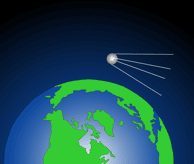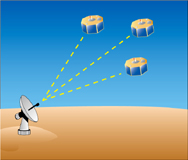Space Technology 5 (ST5) was a formidable technological challenge. The major consideration was size, a fundamental problem in space flight. Using the Space Shuttle as an example, the cost to deploy a payload into low-Earth orbit is about $13,200 per kilogram ($6,000 per pound). As a result, engineers
try to design spacecraft and satellites to be as small as possible. Even so, most satellites with science payloads weigh in excess of 1,000 kilograms (2,200 pounds). Before ST5, the smallest "full-service" micro-sat weighed 100 kilograms (220 pounds). Nanosats are even smaller——in the sub-20 kilograms (38 pounds) range.
 |
We heard Sputnik "beep" as it orbited Earth.
|
These small craft are nothing new. Russia's Sputnik, the first satellite launched into space, weighed only about 90 kilograms (180 pounds). However, Sputnik was and other small satellites are, even decades later, very limited in their capabilities. Typically they lack any propulsion, possess only limited ability for attitude control, and carry one single-function payload.
 |
Ground-to-multiple-satellite communications.
|
Besides size, an additional problem is that almost all space missions are flown with a single craft. This is because controlling spacecraft or satellites in flight is very complicated. Imagine the complexity of flying several satellites as one system. The ground-to-multiple-satellite communications path is more complex than when dealing with a single satellite.
Small, inexpensive, yet highly capable satellites are needed to discover, characterize (describe and measure), and monitor the effects of solar variability throughout near-Earth space. They are needed to help scientists gain a better understanding of the physical processes that cause magnetospheric storms and substorms. In order to increase our knowledge of these processes, we need to obtain simultaneous particles and fields measurements in a range of ~ 5,000 to 15,000 kilometers (just over 3,100 to 9,320 miles) over the mid-plane of the magnetotail between geosynchronous orbit and the orbit of the moon. These simultaneous-measurement requirements can be met only through the deployment of 60 to 100 small, 10-kilogram-(just over 22 pounds) each spacecraft carrying magnetic-fields, plasmas, and energetic-particles instruments.
We also need to characterize space weather, such as the intensity of the Earth's radiation belts. Space weather would be most efficiently tracked over the solar cycle by periodically deploying one or two small satellites carrying particles and fields instruments.
ST5 reduced satellite size while increasing their capabilities. Additionally, the technologies validated by ST5 contribute to the development and eventual deployment of small satellites by NASA and other governmental and commercial organizations.